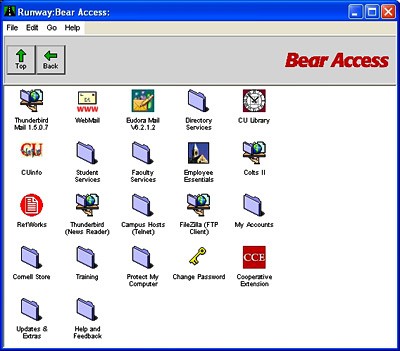Bear Access: Not going away but becoming more DIY
By Bill Steele
Bear Access is about to become a little less spicy and a little more do-it-yourself.
When the SALSA (Software and Licensed Software Acquisition) infrastructure is turned off at the end of June and replaced by BASIL (Bear Access Software Installer and Launcher), your computer will no longer tell you that you don't have the latest version of your e-mail, FTP or Usenet client and automatically download and install it. Even though "installer" is part of the acronym, you still have to scroll down the Bear Access menu and find the installer for the software you need, download it and run it yourself.
"BASIL is a launcher. Using it for installing software just didn't make sense any more," explains Dan Bartholomew of Cornell Information Technologies (CIT) Systems and Operations, who oversees Bear Access. "People are already familiar with downloading and installing software from the Web before they come to Cornell." SALSA works with a special CIT server to download and install what you need. BASIL allows applications to be launched from uPortal using a Web browser.
There's been some confusion over the change to BASIL, including stories that "Bear Access is going away." What will be going away are a number of applications written by CIT staff to run from the Bear Access menu for such activities as updating directory entries or enrolling in courses. These are being replaced by links into the new PeopleSoft Student Administration System, installed this spring.
Bear Access was created in the early 1990s when students, staff and even many faculty were encountering the Internet for the first time when they arrived on campus. It offered a simple menu-driven interface for network computing. Click on "E-mail" and it opened Eudora for you. Click on "Web" and it opened Netscape. (Remember Netscape?) If you didn't have the needed program on your computer — or the latest version — it would download and install it.
The system evolved over time, and now the Bear Access menu is a channel on uPortal. Currently uPortal displays two channels, labeled "Bear Access 2007" and "Bear Access." The first works with the new BASIL. The second invokes the SALSA system (or, if you don't have it, tells you to install it). In a small confusion, the icon for SALSA is a green chili pepper and the icon for BASIL is a green basil leaf. You have to look closely, and remember that the chili pepper leans to the right and the basil leaf to the left.
The confusion will go away in July, when CIT turns off the SALSA server and the old menu disappears. CIT advises all users to download and start using the BASIL infrastructure as soon as possible. An updated version will be available starting June 10. It will require Windows XP with Service Pack 2 installed or higher, or Mac OSX 10.4 (Tiger) or higher. To install BASIL, scroll down the Bear Access 2007 menu to "Installers" and click on "Infrastructure."
Bear Access, Bartholomew says, is really a concept. "It's a a collection of network service applications and links to on-line services that are used to conduct university business which have been bundled together and documented for use at Cornell.," he explains. "We package things, we document them, we explain how they work." There are alternatives for much of the software offered through Bear Access, of course, but "The things we've made available we've tested at Cornell," Bartholomew points out. "Call the Help Desk and they know."
Media Contact
Get Cornell news delivered right to your inbox.
Subscribe